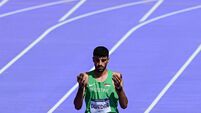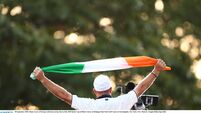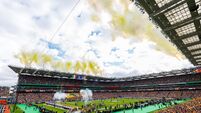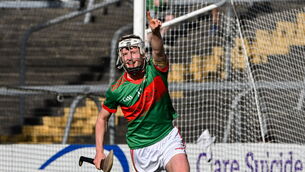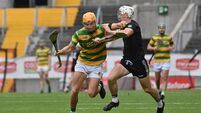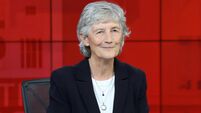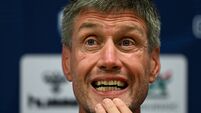Kieran Shannon: The Irish Whales who became the Olympic kings of old New York
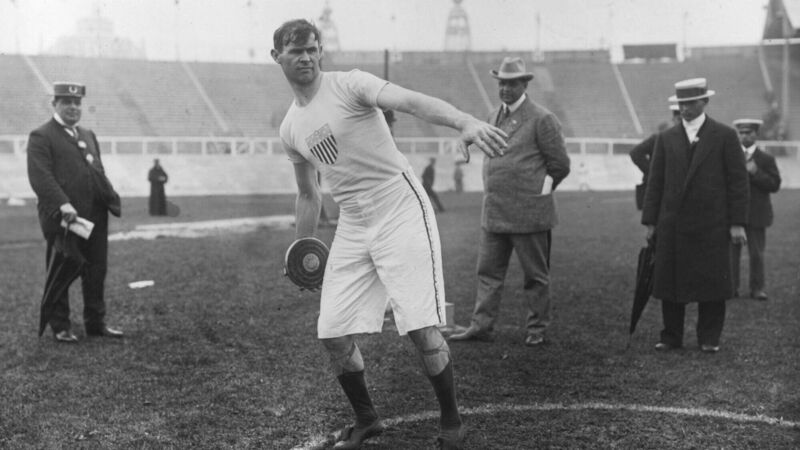
Martin Sheridan’s rightful place in history has been welcomingly preserved, or at least restored, but he was merely one in a line of exceptional Irish athletes at the time. Photo by Topical Press Agency/Getty Images
North Texas, February 1870 Kidd [Tom Hanks]: Good evening, ladies and gentlemen! My name is Captain Jefferson Kyle Kidd and I’m here tonight to bring y’all the news from across this great world of ours. Now I know how life is in these parts — working your trade, sun up to sun down. No time for reading newspapers, right? … So let me do that work for you. And maybe just for tonight, we can escape our troubles and hear of the great changes a’happening out there.
- ‘News of the World’, directed and written by Paul Greengrass (2020)
Around about the same time that Tom Hanks’ latest character was supposed to be going from one Texas town to another, illuminating the illiterate locals on the news of the world, another publication, operating out of the more sophisticated hub of New York, would frequently deride and dehumanise a new segment of its local population.
In Harper’s Weekly, one Thomas Naft, credited as the father of the American political cartoon and the creator of the modern image of Santa Claus, would regularly depict Irish Catholics as not just ill-educated and riotous, but as sub-human, in keeping with Charles Kingsley’s description of the Irish as “human chimpanzees”. According to a Charles Loring Brace in his widely-read Races of the Old World, we even had different skulls to the English, by a whole nine cubic inches.
Earlier, Irish immigrants had been portrayed and received more favourably. Prior to the famine, those who crossed the Atlantic tended to be Ulster Protestant Scots-Irish who, upon arriving in the new world, would tend to settle in rural areas, predominantly Appalachia, where there was free land.
But with the Irish Catholics that followed, it was different. They hadn’t the health or the wealth to move beyond the north-eastern cities where their boats had docked. For as Kevin Martin puts it in his new book, “They had [already] seen too many of the limitations imposed by the vagaries and hardships of trying to make a living off the land. The Irish rejected the land because the land had rejected them.”
It is one of many devastating lines and observations offered by Martin in his terrific new book The Irish Whales: Olympians of Old New York, documenting how an exceptional wave of sportspeople would help transform the Irish from being the runt of New York and American society to being the toast of the town.
Just like Paul Rouse in 2018 with his magnificent The Hurlers, Martin — a native of Crossmolina in Mayo who has taught in communications and Irish social and cultural history — transfers us back to the late 19th century when codified sport was in its infancy, but the Irish were to the forefront of popularising and mastering it.
Martin does not sugarcoat how the Irish were treated or indeed how they treated others in America. While they were initially referred to as “white negroes” just as African-Americans were termed “smoked Irish” and leading activists and abolitionists like Daniel O’Connell and Frederick Douglass had a mutual admiration and empathy for each other and their respective people, in New York the Irish were prepared to walk over other downtrodden populations to get a foot up the social ladder.
Yet sport, and Irish sportspeople, could occasionally offer refuge for the besieged. The Irish American Athletics Club (IACC) was one of over 700 clubs in the greater New York area yet was — by a distance — not only the most successful in the state, but the world. At the 1908 London Olympics, it would win 10 gold medals — more than France, Germany, and Italy combined.
Most of those medals were won by Irishmen or the sons of Irishmen. But one was claimed by their IACC clubmate John Baxter Taylor Jnr, the first African-American to win an Olympic gold medal. While the elitist, WASPish New York Athletics Club discriminated against Jews and other white ethnic working-class communities, the IACC welcomed them.
In the view of Abel Kiviat, a Jewish Olympic middle-distance champion, it was a “kind of poor man’s club”, which in the eyes of a PJ Conway, meant “there’s no excuse in the wurruld for keeping out a man like this excellent” black man.
It was in the throwing events that the club, and especially its Irish membership, excelled in. With numerous athletes already versed in the arts in their native land of Ireland before and through the foundation of the GAA, Ireland — or at least Irish athletes representing the US — dominated the sport for half a century, in much the same way north African athletes dominate middle and long-distance running now.
James ‘Jim’ Mitchell was the sport’s first superstar, a native of Bartoose, near the village of Emly in Co Tipperary, and inspired by the character Matt the Thresher from his fellow countyman Charles Kickhams’ hugely popular novel Knocknagow.
In 1888, he was part of a 53-member party that left Cobh for New York to showcase Irish athletics and the game of hurling; Maurice Davin, who was among the party, had aspirations that hurling could even become one of the great American sports like baseball, another code that the Irish, including the legendary Cornelius McGillicuddy (supposedly abbreviated to Connie Mack so his name could fit on the scoreboard), excelled at.
The tour, however, was ill-fated. Only half of the scheduled events ended up taking place. It ran into financial difficulties, major league hurling never got off the ground, and less than half the original party would return to Ireland. The one overwhelming success though was Mitchell. Within four days of arriving Stateside, he’d smashed three existing records.
In fact, America would love him, and he’d love it in turn so much, he was one of the 29 that would stay put there and go on to win his adopted country a gold medal in the hammer at the 1900 Olympics.
At the subsequent 1904 games John Flanagan, known as the Pocket Rocket, then a native of Limerick, would stand at the top of the podium, while Martin Sheridan, born in Bohola, Mayo, would win gold in the discus.
Sheridan’s rightful place in history has been welcomingly preserved, or at least restored, with the recent publication of Margaret Molloy’s biography of the three-time Olympic champion and his inclusion on the Mayo Sports Mount Rushmore that Newstalk’s Off The Ball ran last year.
But he was merely one in a line of exceptional Irish athletes at the time. From 1900 to 1924, others like Mitchell and Flanagan and Matt McGrath from Nenagh, Pat McDonald from Doonbeg, Patrick Ryan from Pallasgreen, and Con Walsh from Clondrohid would see to it that Irish-North American athletes would amass a remarkable 12 Olympic gold medals, three silvers, and two bronze medals — before a son of their native sod, Dr Pat O’Callaghan, would dominate in the hammer at the 1928 and 1932 Olympics.
Their thirst for sporting excellence and winning was apparently only matched by their appetite for food. On the boat over to the 1912 Stockholm Olympics, the Irish throwers were regularly seen dining together, and ordering four of five soups and three or four steaks per man. At one point, their exhausted and exasperated waiter quipped in passing to an athletics official: “It’s whales they are, not men.”
That was not all that was gigantic about them.
“Now largely forgotten, they were among the biggest international celebrities of their time,” Martin writes in his introduction.
Thanks to his new book, they’re now rightly being remembered.
- ‘The Irish Whales: Olympians of Old New York’ by Kevin Martin, published by Rowman & Littlefield, is available to buy online now

